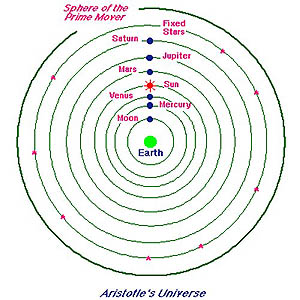 |
Although astronomy is as ancient as recorded history itself, it was long separated from the study of physics. In the Aristotelian worldview, the celestial world tended towards perfection—bodies in the sky seemed to be perfect spheres moving in perfectly circular orbits—while the earthly world seemed destined to imperfection; these two realms were not seen as related. Aristarchus of Samos (c. 310–250 BC) first put forward the notion that the motions of the celestial bodies could be explained by assuming that the Earth and all the other planets in the Solar System orbited the Sun. Unfortunately, in the geocentric world of the time, Aristarchus' heliocentric theory was deemed outlandish and heretical. |
 |
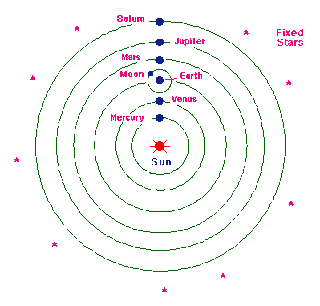 |
For centuries, the apparently common-sense view that the Sun and other planets went round the Earth nearly went unquestioned until the development of Copernican heliocentrism in the 16th century AD. This was due to the dominance of the geocentric model developed by Ptolemy (c. 83-161 AD), a Hellenized astronomer from Roman Egypt, in his Almagest treatise.
|
 |
The only known supporter of Aristarchus was Seleucus of Seleucia, a Babylonian astronomer who is said to have proved heliocentrism through reasoning in the 2nd century BC. This may have involved the phenomenon of tides, which he correctly theorized to be caused by attraction to the Moon and notes that the height of the tides depends on the Moon's position relative to the Sun.[3] Alternatively, he may have determined the constants of a geometric model for the heliocentric theory and developed methods to compute planetary positions using this model, possibly using early trigonometric methods that were available in his time, much like Copernicus.[4] B. L. van der Waerden has interpreted the planetary models developed by Aryabhata (476-550), an Indian astronomer, and Abu Ma'shar al-Balkhi (787-886), a Persian astronomer, to be heliocentric models[5] but this view has been strongly disputed by others.[6] In the 9th century AD, the Persian physicist and astronomer, Ja'far Muhammad ibn Mūsā ibn Shākir, hypothesized that the heavenly bodies and celestial spheres are subject to the same laws of physics as Earth, unlike the ancients who believed that the celestial spheres followed their own set of physical laws different from that of Earth.[7] He also proposed that there is a force of attraction between "heavenly bodies".[8] In the early 11th century, the Arabic Ibn al-Haytham (Alhazen) wrote the Maqala fi daw al-qamar (On the Light of the Moon) some time before 1021. This was the first successful attempt at combining mathematical astronomy with physics, and the earliest attempt at applying the experimental method to astronomy and astrophysics. He disproved the universally held opinion that the moon reflects sunlight like a mirror and correctly concluded that it "emits light from those portions of its surface which the sun's light strikes." In order to prove that "light is emitted from every point of the moon's illuminated surface," he built an "ingenious experimental device." Ibn al-Haytham had "formulated a clear conception of the relationship between an ideal mathematical model and the complex of observable phenomena; in particular, he was the first to make a systematic use of the method of varying the experimental conditions in a constant and uniform manner, in an experiment showing that the intensity of the light-spot formed by the projection of the moonlight through two small apertures onto a screen diminishes constantly as one of the apertures is gradually blocked up."[9] |
In the 14th century, Ibn al-Shatir produced the first model of lunar motion which matched physical observations, and which was later used by Copernicus.[10] In the 13th to 15th centuries, Tusi and Ali Qushji provided the earliest empirical evidence for the Earth's rotation, using the phenomena of comets to refute Ptolemy's claim that a stationary Earth can be determined through observation. Ku??u further rejected Aristotelian physics and natural philosophy, allowing astronomy and physics to become empirical and mathematical instead of philosophical. In the early 16th century, the debate on the Earth's motion was continued by Al-Birjandi (d. 1528), who in his analysis of what might occur if the Earth were rotating, develops a hypothesis similar to Galileo Galilei's notion of "circular inertia", which he described in the following observational test:[11][12] The small or large rock will fall to the Earth along the path of a line that is perpendicular to the plane (sath) of the horizon; this is witnessed by experience (tajriba). And this perpendicular is away from the tangent point of the Earth's sphere and the plane of the perceived (hissi) horizon. This point moves with the motion of the Earth and thus there will be no difference in place of fall of the two rocks. |
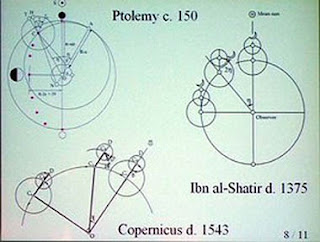 |
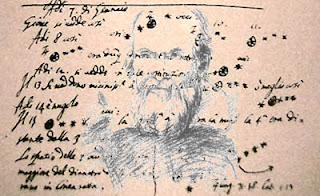 |
After heliocentrism was revived by Nicolaus Copernicus in the 16th century, Galileo Galilei discovered the four brightest moons of Jupiter in 1609, and documented their orbits about that planet, which contradicted the geocentric doctrine of the Catholic Church of his time, and escaped serious punishment only by maintaining that his astronomy was a work of mathematics, not of natural philosophy (physics), and therefore purely abstract. |
| The availability of accurate observational data (mainly from the observatory of Tycho Brahe) led to research into theoretical explanations for the observed behavior. At first, only empirical rules were discovered, such as Kepler's laws of planetary motion, discovered at the start of the 17th century. Later that century, Isaac Newton bridged the gap between Kepler's laws and Galileo's dynamics, discovering that the same laws that rule the dynamics of objects on Earth rule the motion of planets and the moon. Celestial mechanics, the application of Newtonian gravity and Newton's laws to explain Kepler's laws of planetary motion, was the first unification of astronomy and physics. |  |
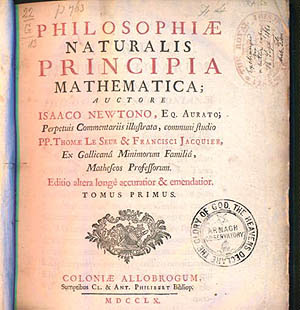 |
After Isaac Newton published his book, Philosophi? Naturalis Principia Mathematica, maritime navigation was transformed. Starting around 1670, the entire world was measured using essentially modern latitude instruments and the best available clocks. The needs of navigation provided a drive for progressively more accurate astronomical observations and instruments, providing a background for ever more available data for scientists. |
At the end of the 19th century, it was discovered that, when decomposing the light from the Sun, a multitude of spectral lines were observed (regions where there was less or no light). Experiments with hot gases showed that the same lines could be observed in the spectra of gases, specific lines corresponding to unique chemical elements. In this way it was proved that the chemical elements found in the Sun (chiefly hydrogen) were also found on Earth. Indeed, the element helium was first discovered in the spectrum of the Sun and only later on Earth, hence its name. During the 20th century, spectroscopy (the study of these spectral lines) advanced, particularly as a result of the advent of quantum physics that was necessary to understand the astronomical and experimental observations.[13] |
 |

No comments:
Post a Comment